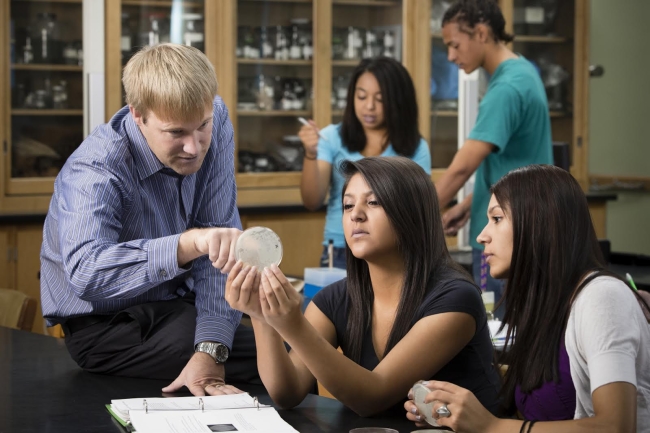You have /5 articles left.
Sign up for a free account or log in.

Luke Daniels, assistant professior of biology at the College of Idaho, helps students.
College of Idaho
Some colleges have tried to move away from "cafeteria" style general education by requiring students to enroll in interdisciplinary courses, or classes that teach certain ways of learning knowledge -- rather than focusing on specific disciplines. The College of Idaho is trying a new approach, in which students pick disciplines, but most go more in-depth than typically is required of non-majors.
“It’s kind of a geek’s dream curriculum,” said Robert Dayley, a professor of political economy at the college and chief architect of its PEAK program that requires students to have one major and three minors in different curricular areas. “You’re challenging the diverse parts of yourself through a guided exploration of your choosing, but the parameters of PEAK require you to do it across the liberal arts.”
PEAK Requirements
- Students must have a major (about 36 credits) and three minors (about 15 credits each).
- The major and minors must be chosen from each of the following four curricular areas: humanities and fine arts; social sciences and history; natural sciences and mathematics; and professional studies and “enhancements.”
- There are 26 majors and 57 minors from which to choose within those areas.
The possible combinations are numerous, but students cannot major and minor or select two minors in the same curricular area. A number of programs qualify as two or more curricular areas, however, such as the environmental studies major and the criminal justice studies minor. So a major and minor in biology and chemistry, for example, is out (unless students elect to complete a fourth minor a second major on top of their three other minors; that choice would likely require the student to complete an extra semester, however).
PEAK is an acronym that stands for professional, ethical, articulate, and knowledgeable – which the college hopes the curriculum will help every student become. (It also takes its name from the mountains surrounding the rural campus.)
The college was reviewing its former, more typical general education requirements in 2009 when the faculty received an email from the incoming president, Marvin Henberg, challenging them to come up with something innovative that still preserved the ideals of a liberal arts education.
“I think of general education as the space where every faculty member claims every student as his or her own even when those students are not majoring in the particular faculty member’s subject area,” Marvin said in an email interview. “So it’s worth preserving a general education program that has the active support of today’s faculty members (PEAK passed without dissent) precisely so that faculty claim and acknowledge joint responsibility for every student’s welfare.”
But at the same time, the College of Idaho's former curriculum needed serious work, Henberg said. It had been “tinkered with in ad hoc fashion, and I could find no one on the faculty who could make a compelling case for its aims.”
He added: “I don’t want to be too hard, for I think this happens at many institutions when there has been, effectively, a generational change in the faculty and new faculty come in without having been part of the conversation that shaped the curriculum of the day.”
However harsh, the faculty largely agreed with Henberg’s assessment.
“It looked a mile wide and an inch deep,” Dayley said of the previous core requirements, under which students took one or two courses in each of the major disciplines before starting coursework on their majors. “It duplicated the high school experience and students didn’t seem very excited by it. They talked about getting courses ‘out of the way.’ ”
Still, Dayley said, prior to Henberg’s email, the faculty review of the curriculum had involved “tweaking on the margins.” The incoming president’s challenge “opened up the door for us to think more radically.”
Dayley conceived of PEAK in consultation with other faculty members, and presented the plan to Henberg, who approved it immediately. The college’s Board of Trustees did as well.
“My endorsement was based on the combined depth and breadth of PEAK,” Henberg said. “A student educated with the breadth and depth of PEAK may well, in the years to come after graduation, find him- or herself drawing more on a minor than a major to take advantage of presently unforeseeable opportunities. Three minors in addition to the major gives a wider base than in most curricula.”
The president also said it offers students “guided autonomy with discipline.” Students, in consultation with faculty advisers, who play a key role in helping students navigate PEAK, select their preferred routes up each PEAK, Henberg said, “but once they have chosen, each minor requires greater depth than in standard general education programs.”
Henberg announced that PEAK would be in place within six months, and it was. The first class to enroll under PEAK did so in fall 2010 (they’ll graduate this year, although some students already at the college who opted into PEAK in 2010 have graduated).
Despite the tight time frame, Dayley said planning for PEAK wasn’t disruptive for the faculty – some 80 professors, the vast majority of whom are tenure-track or tenured. Some new programs were created, such as the human services professional minor, designed to prepare students for careers in the human or social services through coursework in sociology, psychology and anthropology. But many existing programs simply were coded according to PEAK’s curricular areas.
Dayley said faculty conversations about PEAK were different from those typically pertaining to curricular redesign. Notably absent were the “turf battles” over what’s part of the core and what isn’t, he said. (Although PEAK is largely free of required courses, freshmen are required to take a writing and critical thinking-focused seminar taught primarily by English faculty, as well as a civilizations course taught by history faculty.)
Paul Moulton, an associate professor of music and associate dean of academic affairs, said the entire faculty was immediately “enamored” with the idea of PEAK. It “made so much sense,” he said. And while professors had “hesitations” about the actual launch of PEAK – just how it work in the first year – Moulton said he’s only become more confident in the program and its ability to succeed.
In an email he recently sent to colleagues, Moulton shared an essay from a student who had chosen music somewhat as a backup to fulfill his humanities and fine arts minor requirement. Now the student plans to continue composing and ultimately publish music.
“I remember when I first chose to become a music minor – many of my friends and family were surprised,” the student wrote. “I never really had anything to do with music before coming to college: I couldn’t read it, definitely couldn’t write it, and I wouldn’t have been able to tell Beethoven from Mozart from Brahms (I didn’t even know who Brahms was). Now, though, I can do all those things, and more. I’ve gained a deeper understanding of music and music theory than I ever suspected I would before coming to college, and all without a single prior lesson.”
Moulton wrote in his email: “I read it and thought, yeah! PEAK is working.”
Scott A. Johnson, professor and director of the business and accounting program, which was redesigned under PEAK, said the curriculum was the reason he came to the College of Idaho from a faculty position at the University of Greenwich, in Britain.
"At the [business school] where I taught, the preparation for students was even more ‘siloed:' ” he said via email, “three years of courses only in business (primarily in the major program), with no ‘liberal arts’ of any kind (no general education outside the business school required). Thus, when the opportunity arose to help build and integrate a business program with liberal arts through the PEAK framework, I jumped at it.”
Other students are also enthusiastic about PEAK. Clayton Gefre, a junior majoring in creative writing with minors in history, human biology and interactive journalism, said PEAK was a major selling point for the College of Idaho as he was selecting colleges, and he remains happy with his choice.
“I feel like it makes me a whole lot more multifaceted and gives me a lot more experience to draw from as I’m looking into what I want to do as a career,” said Gefre, who hopes to find work as a journalist.
Gefre said friends at other, larger institutions talk about getting required courses “out of the way” before they can move on to their majors. But PEAK allows students to “dive right in” to courses of their choosing, he said.
The creative writing major said PEAK does have its quirks, Gefre said. A friend is frustrated by the fact that she can’t double-major in creative writing and art, and had to lose out on art to graduate on time. Other students encounter scheduling conflicts for required courses for various majors or minors. But Gefre said his own experience has been largely positive and that, over all, the benefits of PEAK outweigh the disadvantages.
Professors and administrators said PEAK is still evolving, and that some details, such as scheduling conflicts, still need to be worked out.
John Ottenhoff, college vice president, also said he’s in talks with the faculty about how to bolster to the “professional” aspect of PEAK, to help students think more about career preparation throughout their course of study – not at the expense of the liberal arts, but alongside them.
“How do you help incoming students start to ask that question, ‘What does it mean to be professional?’ ” he said, noting that the college’s Center for Experiential Learning, which helps students find internships and job opportunities, could play a bigger role in PEAK going forward. “How do you begin to navigate your way through these different minors in liberal arts disciplines that will help prepare you for the workplace?”
PEAK’s also becoming a selling point for the College of Idaho, and way to distinguish itself from so many other small liberal arts colleges – an increasingly important mission. Enrollment has increased 10 percent since 2009, to 1,122 student this fall -- a record high. Professors and administrators referred to the program as a tangible “value added” factor for potential students and their parents. (But they were divided over PEAK's potential for replicability; Henberg said he thought an analog of PEAK could work anywhere, while Dayley said it may face philosophical challenges from faculties at other institutions and, even more so, logistical challenges related to scheduling -- particularly at large universities where core courses often function as "mini-factories.")
But despite the sellable nature of PEAK, both for students going out into the workplace and for the college to applicants, those involved with PEAK said it remained firmly rooted in the liberal arts tradition, and its emphasis on intellectual exploration.
“We’re not telling students this is a strategic course for the job market,” Dayley said, noting that students sometimes are more "strategic" about PEAK than professors. “Students come in as freshmen and they say, ‘These are the four [programs] I want to do,’ but we might say […] ‘You might think a philosophy major is awesome.’ We try to pull them back a little bit.”









